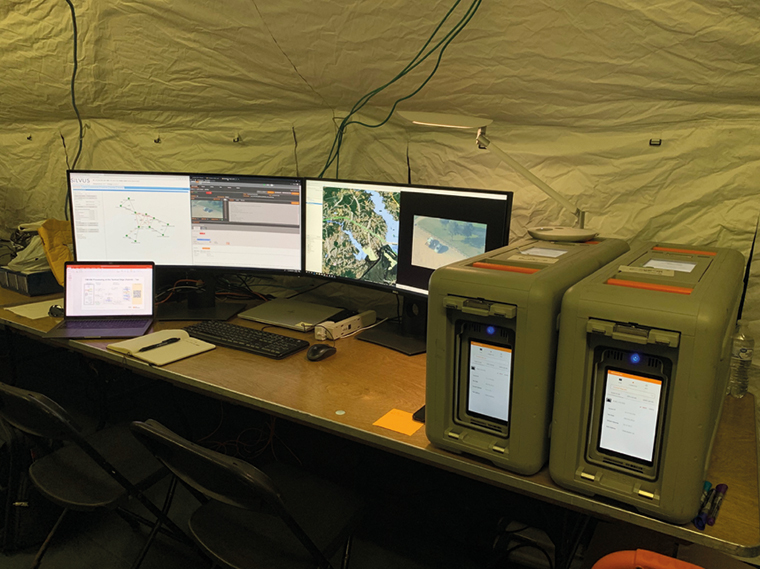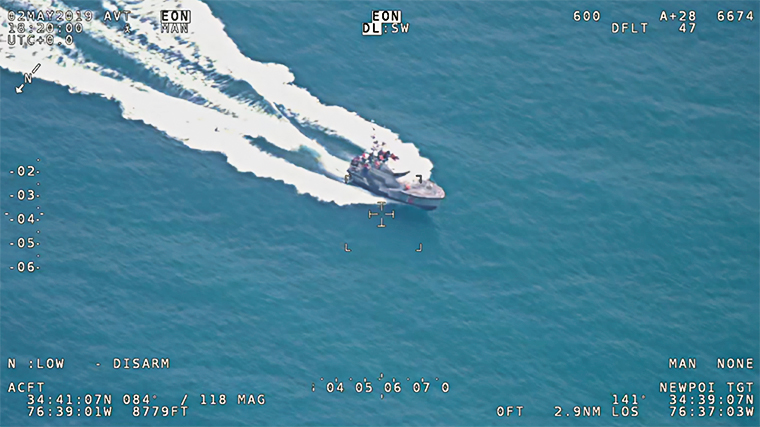The Enterprise Challenge

AWS took part in a situational awareness day, held annually by the US military and its partners. The experience has led to better use of cloud-based video by governments
For governments around the world, video is often the gateway for gathering intelligence and developing awareness of a situation on the ground around the clock. These government organisations rely more and more on full motion video (FMV). Unlike commercial media and entertainment markets, where content is carefully crafted, government organisations can generate and consume huge amounts of content on the fly, in near real time.
Government video can originate in areas of the world far outside its own country, in extreme environments, and may be time sensitive or mission critical. Effective video processing techniques are essential for high image quality and reliable performance, and also improved accessibility when it matters most.
The Enterprise Challenge is an annual American joint and coalition intelligence, surveillance and reconnaissance interoperability demonstration. It’s sponsored by the office of the US Under Secretary of Defense for Intelligence – or USD(I). At this year’s challenge, Amazon Web Services demonstrated how government organisations can combine AWS and AWS Elemental services with traditional video infrastructure to improve video processing at the tactical edge.
The event served as an operational proving ground, applying cloud-enabled technologies to real-time simulated mission environments. These real-world scenarios include how emergency responders could be supported with aerial video after an infrastructure-crippling natural disaster, how footage could be furnished to troops on the ground in a combat scenario and how airborne sensor-equipped systems might provide another set of eyes to vessels in a search-and-rescue mission at sea.
AWS Elemental demonstrated various aspects of a hybrid cloud workflow, leveraging AWS services aimed at improving the FMV quality of experience over constrained ground-based RF networks. It distributed reliable video streams to local tactical users and performed protected contribution of live FMV content to AWS Cloud Regions.
The architecture involved use of a number of AWS services, including AWS Elemental Live on-premises encoding systems, combined with AWS Elemental MediaConnect, MediaLive, and MediaPackage for video transport, encoding, packaging and origination.
In addition, nearly a half-dozen AWS Partner Network (APN) partners were involved in the exercise, deploying technologies that included ISR (intelligence, surveillance and reconnaissance) sensor systems, which used AWS Elemental Live small form-factor HEVC/H.265 encoding on platform and PED (processing, exploitation, dissemination) video/geospatial applications running on Amazon Machine Images, powered by AWS Snowball Edge Compute and Storage Optimized devices.
During the event, attendees shared insights about the challenges associated with their mission video systems. In response, AWS developed a strategy for implementing a hybrid workflow to enhance video performance, quality and resiliency in disconnected, intermittent and limited-bandwidth environments:
 1. Embrace Hybrid Full Motion Video and Streaming
Until recently, most government video systems mirrored legacy commercial broadcast and IPTV designs – a camera connected to an AVC or HEVC encoder, compressing video, encapsulating using traditional MPEG-2 transport streams and transmitting over a managed IP network. These flows involved laborious IP multicasting protocols.
Evolutions in media and entertainment streaming technologies and the cloud offer government organisations new tools to implement hybrid cloud and on-premises architectures that support broadcast-quality video for enterprise and tactical operations. The architecture pulls from familiar commercial contribution techniques using MPEG-2-based transport streams, combined with ground or cloud-based adaptive bit rate (ABR) video processing, aimed to improve quality across the enterprise.
Currently, MPEG-2 transport streams are still best for contribution when implementing a hybrid FMV streaming architecture. They provide predictable real-time performance from existing sensor systems from air-to-ground, air-to-cloud, or ground-to-cloud scenarios. To improve picture quality and reduce bit rate, HEVC/H.265 video compression should be considered as the video contribution format.
For distribution of FMV streams, OTT streaming formats, such as HTTP Live Streaming (HLS), Dynamic Adaptive Streaming over HTTP (DASH), or Common Media Application Format (CMAF) are best. They offer ABR profiles, allowing the same live stream to be encoded at single or multiple renditions, from high quality, higher bit rate to low quality, lower bit rate.
2. Improve Quality of Experience
[caption id="attachment_4956" align="alignnone" width="760"]
1. Embrace Hybrid Full Motion Video and Streaming
Until recently, most government video systems mirrored legacy commercial broadcast and IPTV designs – a camera connected to an AVC or HEVC encoder, compressing video, encapsulating using traditional MPEG-2 transport streams and transmitting over a managed IP network. These flows involved laborious IP multicasting protocols.
Evolutions in media and entertainment streaming technologies and the cloud offer government organisations new tools to implement hybrid cloud and on-premises architectures that support broadcast-quality video for enterprise and tactical operations. The architecture pulls from familiar commercial contribution techniques using MPEG-2-based transport streams, combined with ground or cloud-based adaptive bit rate (ABR) video processing, aimed to improve quality across the enterprise.
Currently, MPEG-2 transport streams are still best for contribution when implementing a hybrid FMV streaming architecture. They provide predictable real-time performance from existing sensor systems from air-to-ground, air-to-cloud, or ground-to-cloud scenarios. To improve picture quality and reduce bit rate, HEVC/H.265 video compression should be considered as the video contribution format.
For distribution of FMV streams, OTT streaming formats, such as HTTP Live Streaming (HLS), Dynamic Adaptive Streaming over HTTP (DASH), or Common Media Application Format (CMAF) are best. They offer ABR profiles, allowing the same live stream to be encoded at single or multiple renditions, from high quality, higher bit rate to low quality, lower bit rate.
2. Improve Quality of Experience
[caption id="attachment_4956" align="alignnone" width="760"] Mission possible: As OTT and streaming technologies improve, mission video systems are being transformed[/caption]
Live video contribution over RF transmission systems are vulnerable to packet loss if not provisioned for error recovery. Dropped packets equate to data loss, which degrades the quality of experience at the client side decoder. Poor quality of experience (QoE) could be in the form of video pixelation, choppy playback, artefacts, or freeze frames. While wireless RF transmission systems can be rapidly deployed in tactical environments, they can exhibit unpredictable behaviours when pushed to their limits.
Though by nature of the protocol, UDP/IP flows are unreliable, they are heavily deployed in mission systems. Toggling these flows to real-time transport protocol (RTP) can improve stream resiliency. RTP was designed for real-time transfer of audio/video information over IP networks and includes several techniques that can better facilitate media-based delivery systems including timestamps, sequence numbers and payload types, which can be helpful in addressing common issues such as late or out-of-order packets.
There are many ways to measure the general health and performance of a network. One practice is the basic ”ping” test, which uses a combination of ICMP control messages (Echo Request and Echo Reply) to measure specific conditions such as packet loss, latency and throughput between a source and destination.
Ping is a common command line utility found on most operating systems and can provide good metrics about network conditions. Other forms of contribution encoding, such as ground-to-cloud, may be better off using more advanced packet protection methods that can guarantee media delivery. During Enterprise Challenge, the ground-based system terminated the aircraft RTP-FEC flow, then re-encapsulated it as a ground-to-cloud flow using reliable transport technology from Zixi.
The Zixi transport protocol provides added network resiliency through a combination of applied FEC and ARQ (Automatic Repeat Request) for advanced error-recovery. It is offered on the AWS Elemental MediaConnect service using ground and cloud-based link components for secure, reliable live video transport.
Mission possible: As OTT and streaming technologies improve, mission video systems are being transformed[/caption]
Live video contribution over RF transmission systems are vulnerable to packet loss if not provisioned for error recovery. Dropped packets equate to data loss, which degrades the quality of experience at the client side decoder. Poor quality of experience (QoE) could be in the form of video pixelation, choppy playback, artefacts, or freeze frames. While wireless RF transmission systems can be rapidly deployed in tactical environments, they can exhibit unpredictable behaviours when pushed to their limits.
Though by nature of the protocol, UDP/IP flows are unreliable, they are heavily deployed in mission systems. Toggling these flows to real-time transport protocol (RTP) can improve stream resiliency. RTP was designed for real-time transfer of audio/video information over IP networks and includes several techniques that can better facilitate media-based delivery systems including timestamps, sequence numbers and payload types, which can be helpful in addressing common issues such as late or out-of-order packets.
There are many ways to measure the general health and performance of a network. One practice is the basic ”ping” test, which uses a combination of ICMP control messages (Echo Request and Echo Reply) to measure specific conditions such as packet loss, latency and throughput between a source and destination.
Ping is a common command line utility found on most operating systems and can provide good metrics about network conditions. Other forms of contribution encoding, such as ground-to-cloud, may be better off using more advanced packet protection methods that can guarantee media delivery. During Enterprise Challenge, the ground-based system terminated the aircraft RTP-FEC flow, then re-encapsulated it as a ground-to-cloud flow using reliable transport technology from Zixi.
The Zixi transport protocol provides added network resiliency through a combination of applied FEC and ARQ (Automatic Repeat Request) for advanced error-recovery. It is offered on the AWS Elemental MediaConnect service using ground and cloud-based link components for secure, reliable live video transport.
3. Carrying Metadata over ABR Video provides situational awareness, but doesn’t offer insight as to where activity took place, which is where metadata comes into play. Full motion video streams generally contain geospatial metadata found in a data encoding standard known as KLV (Key-Length-Value). The underlying metadata contains specific location information about the video from the camera sensor or aircraft perspective (eg latitude, longitude, altitude, etc.). From a distribution standpoint, FMV streams are transformed from MPEG-2 transport stream encapsulation to newer adaptive streaming formats, such as MPEG-DASH and HLS. Since these streaming protocols were designed to serve media and entertainment content over the internet, there was not a well-documented methodology to carry KLV information in the consumer market as there was with MPEG-2 transport streams. However, if KLV metadata were filtered out or lost in translation, FMV content would be less useful to an analyst, providing the most basic situational awareness without the descriptive geospatial data required for processing, exploitation and dissemination workflows. To overcome this obstacle and preserve the mission-oriented KLV metadata in an FMV streaming environment, AWS Elemental implemented the carriage of KLV in the fMP4 containers capable of facilitating many mainstream ABR formats in use today. Mission video systems are undergoing an evolution, as OTT and streaming developments open new opportunities for government agencies to access, review and analyse video from the field like never before.]]>Until recently, most government video systems mirrored legacy commercial broadcast and IPTV designs











